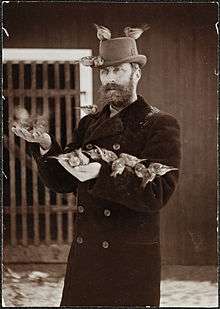Robert Collett

Robert Collett (2 December 1842 – 27 January 1913) was a Norwegian zoologist. Collett was director and curator of the Zoological Museum at University of Oslo.[1]
Robert Collett was born at Christiania (now Oslo), Norway. He was the eldest child of Professor Peter Jonas Collett (1813–51) and Camilla Collett (1813–95). His maternal uncles included Oscar and Henrik Wergeland, and his paternal uncles included Peter Severin Steenstrup. He had three younger brothers, including the writer and historian, Alf Collett. He never married. [2] [3] [4] [5]
He attended the Latin School in Lillehammer and was a fellow in zoology at the University of Oslo. From 1864 he was curator at the Zoological Museum in Oslo. In 1882 he became its director and was appointed professor in 1885. He worked with vertebrates, primarily fishes. He described many new species of fish, spiders and other organisms.[6][7]
A popular book Norges pattedyr written by him was on the mammals of Norway. This book was to influence Charles Elton to study the periodic fluctuations in animal populations. The work by Elton on animal fluctuations, particularly those of lemmings challenged the idea that there was a balance in nature.[8]
References
- ↑ Arne Semb-Johansson. "Robert Collett". Norsk biografisk leksikon. Retrieved January 1, 2017.
- ↑ Robert Collett University of Oslo
- ↑ Sigurd Aa. AarnesKristin Ørjasæter. "Jonas Collett - 2". Norsk biografisk leksikon. Retrieved January 1, 2017.
- ↑ Kristin Ørjasæter. "Camilla Collett". Norsk biografisk leksikon. Retrieved January 1, 2017.
- ↑ Terje Bratberg. "Alf Collett, Jurist, Historiker, Genealog". Norsk biografisk leksikon. Retrieved January 1, 2017.
- ↑ Collett, R. (1879). "On a new Fish of the Genus Lycodes from the Pacific.". Proceedings of the Zoological Society of London. 47: 381–382. doi:10.1111/j.1096-3642.1879.tb02667.x.
- ↑ "Robert Collett". Store norske leksikon. Retrieved January 1, 2017.
- ↑ Stenseth, NC (1995). "The long-term study of voles, mice and lemmings: homage to Robert Collett". Trends Ecol. Evol. 10 (12): 512.